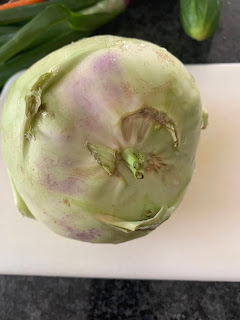The other day, a friend told me that she had received a couple of beets from the All Peoples garden. She had eaten store-bought, canned beets before, but had never eaten a fresh beet in her whole life. She wanted to know how to cook it. So, let's talk about beets!
 |
| Photo credit: Culinary Hill |
Beet Basics
Beets have three basic parts: the leaves, the stems and the bulb or root. Beets come in different colors, usually described as golden beets or red beets. When we think about eating beets, we usually think about the big round root bulb, but we can actually eat all of these parts of the beet plant.
Beet leaves are great for using in salad, if they are small and tender. Use a scissors or a knife to cut them from the beet stems, and be sure to wash the leaves well. Bigger leaves can be cooked in the same way that you might cook Swiss chard or collard greens.
The stems are also edible, and can be used in the same way that you might use celery. The bigger ones can be tough and stringy, so those might be better off in the compost pile than on your dinner plate.
The beet root itself might be big, might or might be small. The bigger the beet, the tougher it might be. If you want to eat the beet raw, you need to wash it really well, peel it with a potato peeler and then grate it. There are many recipes online for grated beet salad. Most recipes call for cooked beets. If you have big beets, it is best to cook them.
If you are going to cook your beets, or use them in a recipe such as pickled beets, the easiest way to remove the peel is to boil the beets. Use a scissors or knife to cut the stems, leaving just a little bit of each stem still on the beet. Wash the beets really well, and put them in a pot. Cover them with water and set them on the stove to boil until they are tender enough to stick a fork in them. Do not boil them until they are mushy. You can save that beet water to use for soup stock or as the liquid to make pink tortillas or bread or muffins. Let the beets cool a bit. Stick a fork into the end with the stem bits and gently use a paring knife to slip the skins off toward the fork. Lastly, set the beet down and cut off the stem end, like you would an onion.
The cooked, peeled beets are then ready to eat. You can eat them warm or make a beet salad or use them in a recipe. When I was growing up, we picked beets and ate them several times each week, usually warm with a little butter on them (which I personally DO NOT like). My grandmothers always canned jars and jars of pickled beets every summer (which I personally LOVE). If I have beets, I usually make beet salad with goat cheese or I make pickled beets.
This year, I was looking through my grandma's cookbooks and found a recipe for Beet Relish, submitted to a community cookbook in 1923. I decided to give it a try, and I am very glad I did!
Beet Relish Recipe
 |
This is the original recipe as it appears in the cookbook.
|
 |
I put my cooked, peeled beets into my food processor. I scooped one cup
of ground beets into a measuring cup, and estimated I had 1 1/2 cups total.
This is where fraction math comes in handy! 1 1/2 cups, or 3/2 cups is 3/4 of
the original recipe. Multiply each ingredient by 3/4 to make the adjustment.
If you need help with that, be sure to contact Miss Linda for math lesson
at Peeps Academy! |
 |
This is what the beet relish looked like once I added all of the other
ingredients. |
 |
I like to store relish and pesto in small canning jars. Because there
is butter in this recipe, the relish cannot be canned in sealed jars for storing
in the pantry. Instead, it is best stored in the freezer. |
 |
It is important to label your homemade items so you are sure to use the
oldest things first. |
 |
Are you curious about this? Do you see my frozen saved beet water?
This is the collection of stuff I saved from one week of harvesting, freezing,
canning and cooking. The celery water and beet water melt down with the
vegetable scraps to make a nice vegetable stock, which I cooked, strained and froze for soup. |
What kinds of things do you like to make with beets? Maybe you can try out a new recipe and post a photo in the comments.
Note: Beets are very good for you and if you eat a bunch of the red ones, yes, your pee will turn pink.
Submitted by Linda Muth


















































